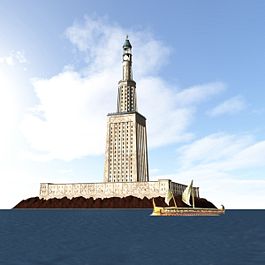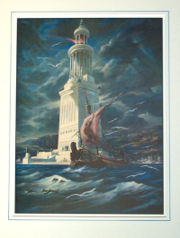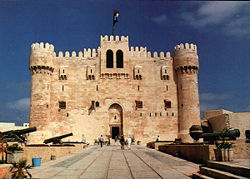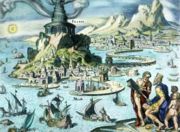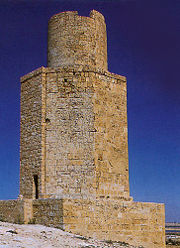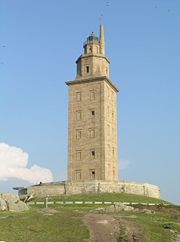Lighthouse of Alexandria
2008/9 Schools Wikipedia Selection. Related subjects: Ancient History, Classical History and Mythology
| Lighthouse of Alexandria | |
|---|---|
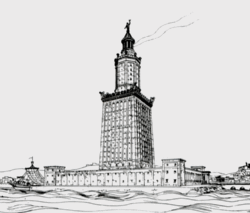 A drawing of the lighthouse by German archaeologist Prof. H. Thiersch (1909). |
|
| Location: | Pharos, Alexandria, Egypt |
| Coordinates WGS-84 ( GPS) |
|
| Deactivated: | 1303/ 1323 |
| Foundation: | Stone |
| Construction: | Masonry |
| Height: | 115 ~ 150 m (377 ~ 492 ft) |
| Range: | 56 km (35 miles) |
The lighthouse of Alexandria (or The Pharos of Alexandria, Greek: ὁ Φάρος τῆς Ἀλεξανδρείας) was a tower built in the 3rd century BC (between 285 and 247 BC) on the island of Pharos in Alexandria, Egypt to serve as that port's landmark, and later, its lighthouse.
With a height variously estimated at between 115 ~ 150 meters (377 ~ 492 ft) it was among the tallest man-made structures on Earth for many centuries, and was identified as one of the Seven Wonders of the World by Antipater of Sidon. It may have been the third tallest building after the two Great Pyramids (of Khufu and Khafra) for its entire life. Some scholars estimate a much taller height exceeding 180 meters that would make the tower the tallest building up to the 14th century.
History
Pharos was a small island just off the coast of Alexandria. It was linked to the mainland by a man-made connection named the Heptastadion, which thus formed one side of the city's harbour. As the Egyptian coast is very flat and lacking in the kind of landmark used at the time for navigation, a marker of some sort at the mouth of the harbour was deemed necessary - a function the Pharos was initially designed to serve. Use of the building as a lighthouse, with a fire and reflective mirrors at the top, is thought to date to around the 1st century AD, during the Roman period. Prior to that time the Pharos served solely as a landmark or day beacon.
Construction and destruction
The lighthouse was completed in the 3rd century BC, after having been initiated by Satrap (governor) Ptolemy I Soter, Egypt's first Hellenistic ruler and a general of Alexander the Great. After Alexander died unexpectedly at age 33, Ptolemy Soter (Saviour, named so by the inhabitants of Rhodes) made himself king in 305 BC and ordered the construction of the Pharos shortly thereafter. The building was finished during the reign of his son, Ptolemy Philadelphos.
According to legend, Sostratus was forbidden by Ptolemy from putting his name on his work. But the architect left the following inscription on the base's walls nonetheless: Sostratus, the son of Dexiphanes, the Cnidian, dedicated (or erected) this to the Saviour Gods, on behalf of those who sail the seas, the original Greek inscription ΣΟΣΤΡΑΤΟΣ ΔΕΞΙΦΑΝΟΥ ΚΝΙΔΙΟΣ ΘΕΟΙΣ ΣΩΤΕΡΣΙΝ ΥΠΕΡ ΤΩΝ ΠΛΩΙΖΟΜΕΝΩΝ literally means: Sostratos of Dexiphanes [meaning: son of Dexiphanes] the Cnidian to Saviour Gods for the seafarers (or sea-faring [ones]). These words were hidden under a layer of plaster, on top of which was chiselled another inscription honouring Ptolemy the king as builder of the Pharos. After centuries the plaster wore away, revealing the name of Sostratus.
There are ancient claims the light from the lighthouse could be seen from up to 35 miles (56 km) away. Unconfirmed legends claim the light from Pharos could burn enemy ships before they reached shore.
Constructed from large blocks of light-coloured stone, the tower was made up of three stages: a lower square section with a central core, a middle octagonal section, and, at the top, a circular section. At its apex was positioned a mirror which reflected sunlight during the day; a fire was lit at night. Extant Roman coins struck by the Alexandrian mint show that a statue of a triton was positioned on each of the building's four corners. A statue of Poseidon stood atop the tower during the Roman period.
The Pharos' walls were strengthened in order to withstand the pounding of the waves through the use of molten lead to hold its masonry together, and possibly as a result the building survived the longest of the Seven Wonders - with the sole exception of the Great Pyramid of Giza. It was still standing when the Muslim traveller Ibn Jubayr visited the city in 1183. He said of it that: "Description of it falls short, the eyes fail to comprehend it, and words are inadequate, so vast is the spectacle." It appears that in his time there was a church located on the top.
The tower was severely damaged by two earthquakes in 1303 and 1323, to the extent that the Arab traveler Ibn Battuta reported not being able to enter the ruin. Even the stubby remnant disappeared in 1480, when the then-Sultan of Egypt, Qaitbay, built a medieval fort on the former location of the building, using some of the fallen stone. The remnants of the Pharos that were incorporated into the walls of Fort Qaitbey are clearly visible due to their excessive size in comparison to surrounding masonry.
Recent archaeological research
Some remains of the lighthouse were found on the floor of Alexandria's Eastern Harbour by divers in 1994. More of the remains have subsequently been revealed by satellite imaging.
A Nova program chronicled the underwater discovery of the fabled Pharos lighthouse. It is possible to go diving and see the ruins.
Significance
Pharos became the etymological origin of the word 'lighthouse' in Greek (φάρος), Bulgarian (фар) and many Romance languages, such as French (phare), Italian (faro), Portuguese (farol), Spanish (faro), Romanian and Catalan (far), and Swedish ("Fyr").
The design of minarets in many early Islamic mosques many centuries later followed a similar three-stage design to that of the Pharos, attesting to the building's broader architectural influence.
Pharos in culture
In architecture
- A well-preserved ancient tomb in the town of Abu Qir, 20 kilometres (12 mi) east of Alexandria, is thought to be a scaled-down model of the Alexandria Pharos. Known colloquially under various names - the Pharos of Abuqir, the Abuqir funerary monument and Burg al-Arab (Arab's Tower) - it consists of a 3-story tower, approximately 20 metres (66 ft) in height, with a square base, a hexagonal midsection and cylindrical upper section, like the building upon which it was apparently modeled. It dates to the reign of Ptolemy II (285-246 BC), and is therefore likely to have been built at about the same time as the Alexandria Pharos.
- The Tower of Hercules, near A Coruña in Spain, a 2nd century AD Roman lighthouse, is closely modelled on the Alexandrian Pharos.
- A replica of the Lighthouse of Alexandria was constructed in the Window of the World Cultural Park in Shenzhen, China.
- The design of the George Washington Masonic National Memorial in Alexandria, Virginia was partially inspired by the Lighthouse of Alexandria.
- The fate of the Lighthouse of Alexandria from the Arab conquest until its collapse in the 14th century has been investigated by Doris Behrens-Abouseif in her article "The Islamic History of the Lighthouse of Alexandria" (in: Muqarnas XXIII [2006], pp. 1-14)
In books
Matthew Reilly uses this ancient wonder as the location of a piece of the golden capstone in his latest novel Seven Ancient Wonders.
In the cultural section from Book 2 of Cambridge Latin Course, the Pharos of Alexandria is mentioned along with the history of Alexandria, one of the greatest international ports of the ancient world.
Other
- In the beginning of 2K Games's game, BioShock, the player is forced to swim towards a lighthouse, the entrance to an underground city known as "Rapture", that closely resembles the Lighthouse of Alexandria.
